Analysis of Procurement Issues: Berlin Brandenburg Airport Case Study
VerifiedAdded on 2022/09/05
|14
|3412
|35
Report
AI Summary
This report examines the procurement process of the Berlin Brandenburg Airport (BER), a case study of significant project failure. It delves into the issues surrounding public sector procurement, including challenges with stakeholder management, ineffective planning, and scope changes. The report analyzes the procurement process, contract management, sourcing, and selection, as well as the negotiation of commercial terms and risk management. It highlights the impact of inadequate project governance, insufficient understanding of business needs, and problems with specifications and contracts. The report offers recommendations for improved management of large-scale projects, emphasizing the importance of effective project leadership, stakeholder engagement, and robust risk management strategies. The report also highlights the importance of clear scope definition, proper contract management, and the use of tools like Monte Carlo simulation and PERT for effective project execution and risk mitigation. The report concludes by emphasizing the lessons learned from the BER project failure and the importance of applying these lessons to future infrastructure projects.

Running head: BERLIN BRANDENBURG
Berlin Brandenburg Airport Project
Name of Student
Name of University
Author Note
Berlin Brandenburg Airport Project
Name of Student
Name of University
Author Note
Paraphrase This Document
Need a fresh take? Get an instant paraphrase of this document with our AI Paraphraser
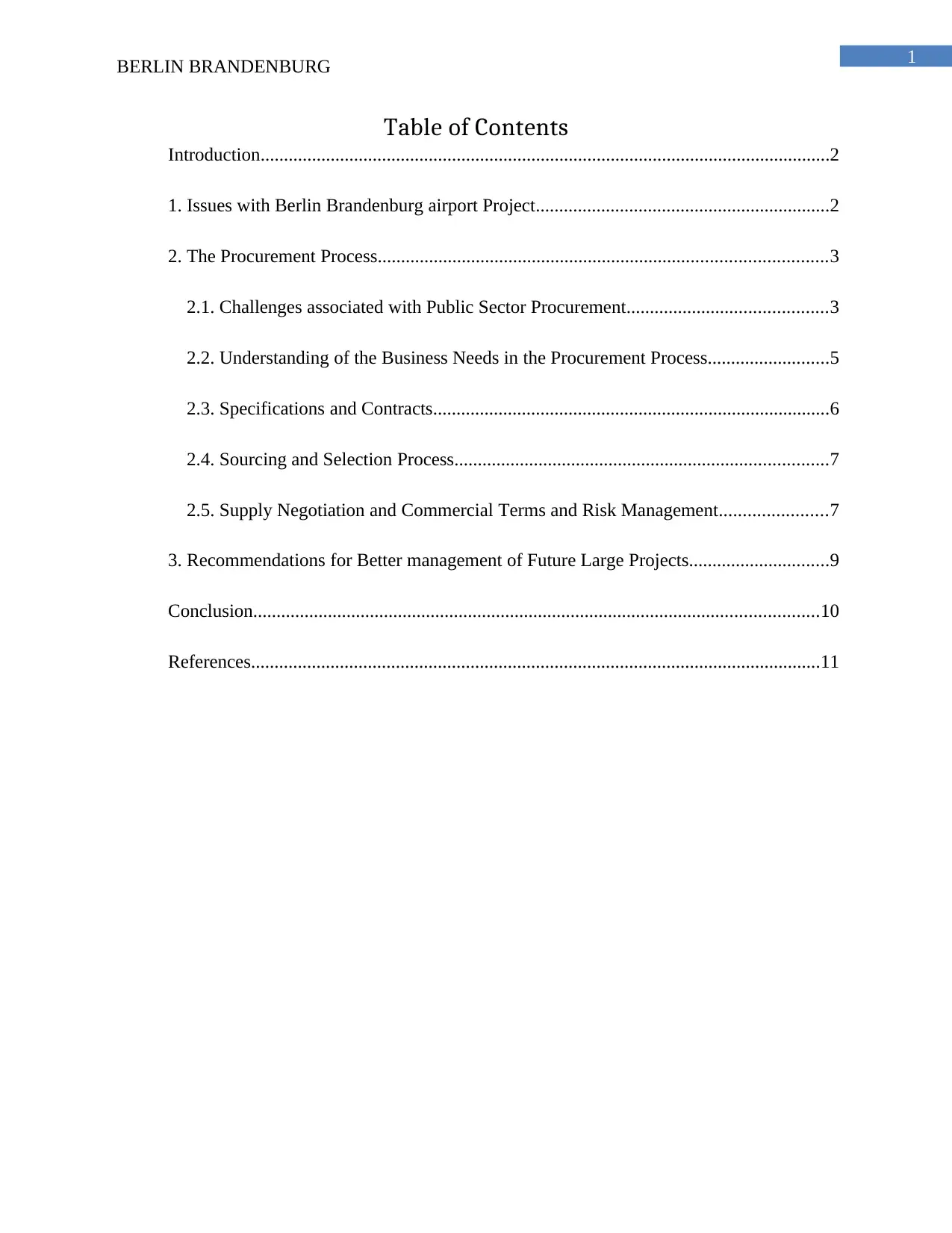
1
BERLIN BRANDENBURG
Table of Contents
Introduction..........................................................................................................................2
1. Issues with Berlin Brandenburg airport Project...............................................................2
2. The Procurement Process................................................................................................3
2.1. Challenges associated with Public Sector Procurement...........................................3
2.2. Understanding of the Business Needs in the Procurement Process..........................5
2.3. Specifications and Contracts.....................................................................................6
2.4. Sourcing and Selection Process................................................................................7
2.5. Supply Negotiation and Commercial Terms and Risk Management.......................7
3. Recommendations for Better management of Future Large Projects..............................9
Conclusion.........................................................................................................................10
References..........................................................................................................................11
BERLIN BRANDENBURG
Table of Contents
Introduction..........................................................................................................................2
1. Issues with Berlin Brandenburg airport Project...............................................................2
2. The Procurement Process................................................................................................3
2.1. Challenges associated with Public Sector Procurement...........................................3
2.2. Understanding of the Business Needs in the Procurement Process..........................5
2.3. Specifications and Contracts.....................................................................................6
2.4. Sourcing and Selection Process................................................................................7
2.5. Supply Negotiation and Commercial Terms and Risk Management.......................7
3. Recommendations for Better management of Future Large Projects..............................9
Conclusion.........................................................................................................................10
References..........................................................................................................................11
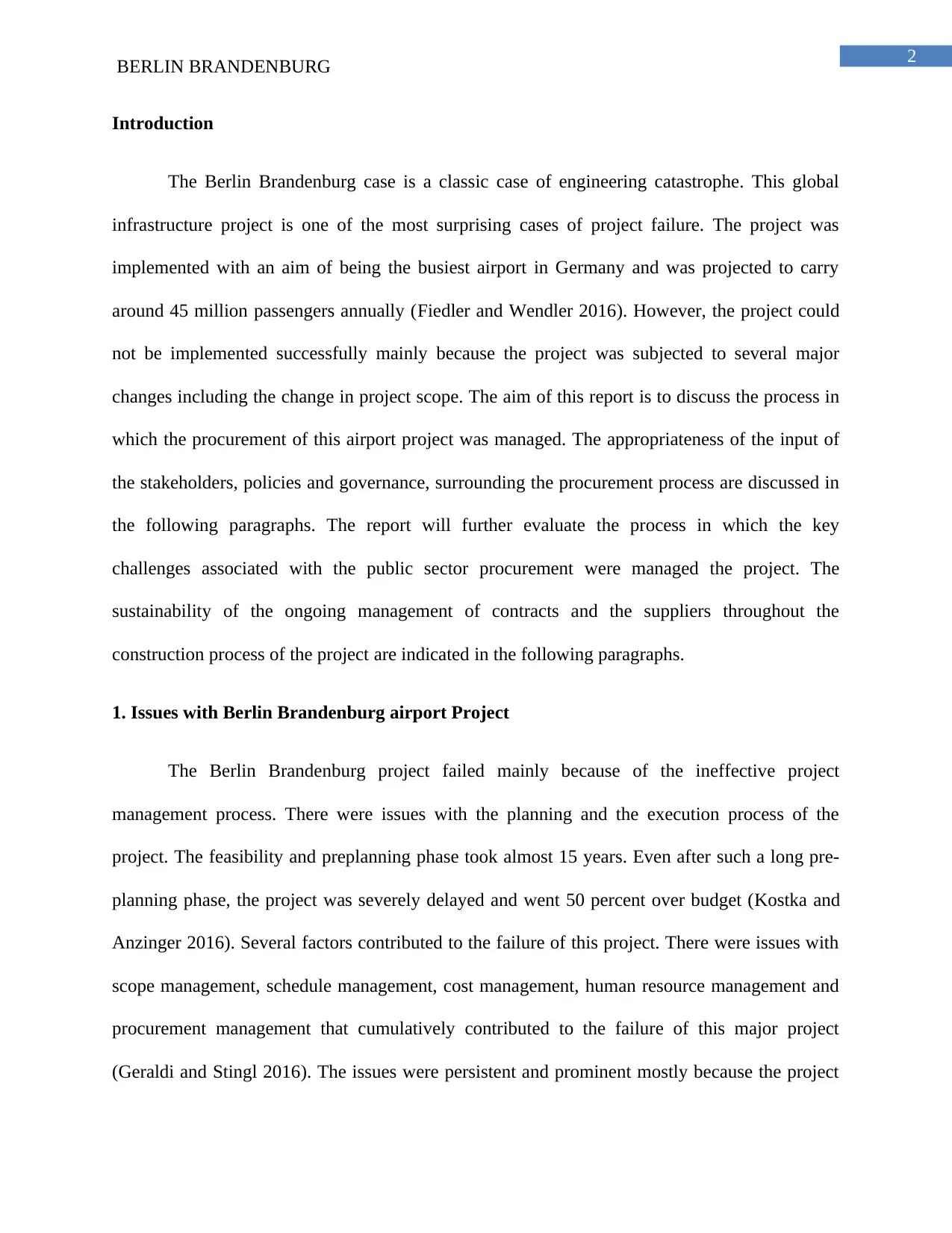
2
BERLIN BRANDENBURG
Introduction
The Berlin Brandenburg case is a classic case of engineering catastrophe. This global
infrastructure project is one of the most surprising cases of project failure. The project was
implemented with an aim of being the busiest airport in Germany and was projected to carry
around 45 million passengers annually (Fiedler and Wendler 2016). However, the project could
not be implemented successfully mainly because the project was subjected to several major
changes including the change in project scope. The aim of this report is to discuss the process in
which the procurement of this airport project was managed. The appropriateness of the input of
the stakeholders, policies and governance, surrounding the procurement process are discussed in
the following paragraphs. The report will further evaluate the process in which the key
challenges associated with the public sector procurement were managed the project. The
sustainability of the ongoing management of contracts and the suppliers throughout the
construction process of the project are indicated in the following paragraphs.
1. Issues with Berlin Brandenburg airport Project
The Berlin Brandenburg project failed mainly because of the ineffective project
management process. There were issues with the planning and the execution process of the
project. The feasibility and preplanning phase took almost 15 years. Even after such a long pre-
planning phase, the project was severely delayed and went 50 percent over budget (Kostka and
Anzinger 2016). Several factors contributed to the failure of this project. There were issues with
scope management, schedule management, cost management, human resource management and
procurement management that cumulatively contributed to the failure of this major project
(Geraldi and Stingl 2016). The issues were persistent and prominent mostly because the project
BERLIN BRANDENBURG
Introduction
The Berlin Brandenburg case is a classic case of engineering catastrophe. This global
infrastructure project is one of the most surprising cases of project failure. The project was
implemented with an aim of being the busiest airport in Germany and was projected to carry
around 45 million passengers annually (Fiedler and Wendler 2016). However, the project could
not be implemented successfully mainly because the project was subjected to several major
changes including the change in project scope. The aim of this report is to discuss the process in
which the procurement of this airport project was managed. The appropriateness of the input of
the stakeholders, policies and governance, surrounding the procurement process are discussed in
the following paragraphs. The report will further evaluate the process in which the key
challenges associated with the public sector procurement were managed the project. The
sustainability of the ongoing management of contracts and the suppliers throughout the
construction process of the project are indicated in the following paragraphs.
1. Issues with Berlin Brandenburg airport Project
The Berlin Brandenburg project failed mainly because of the ineffective project
management process. There were issues with the planning and the execution process of the
project. The feasibility and preplanning phase took almost 15 years. Even after such a long pre-
planning phase, the project was severely delayed and went 50 percent over budget (Kostka and
Anzinger 2016). Several factors contributed to the failure of this project. There were issues with
scope management, schedule management, cost management, human resource management and
procurement management that cumulatively contributed to the failure of this major project
(Geraldi and Stingl 2016). The issues were persistent and prominent mostly because the project
⊘ This is a preview!⊘
Do you want full access?
Subscribe today to unlock all pages.

Trusted by 1+ million students worldwide
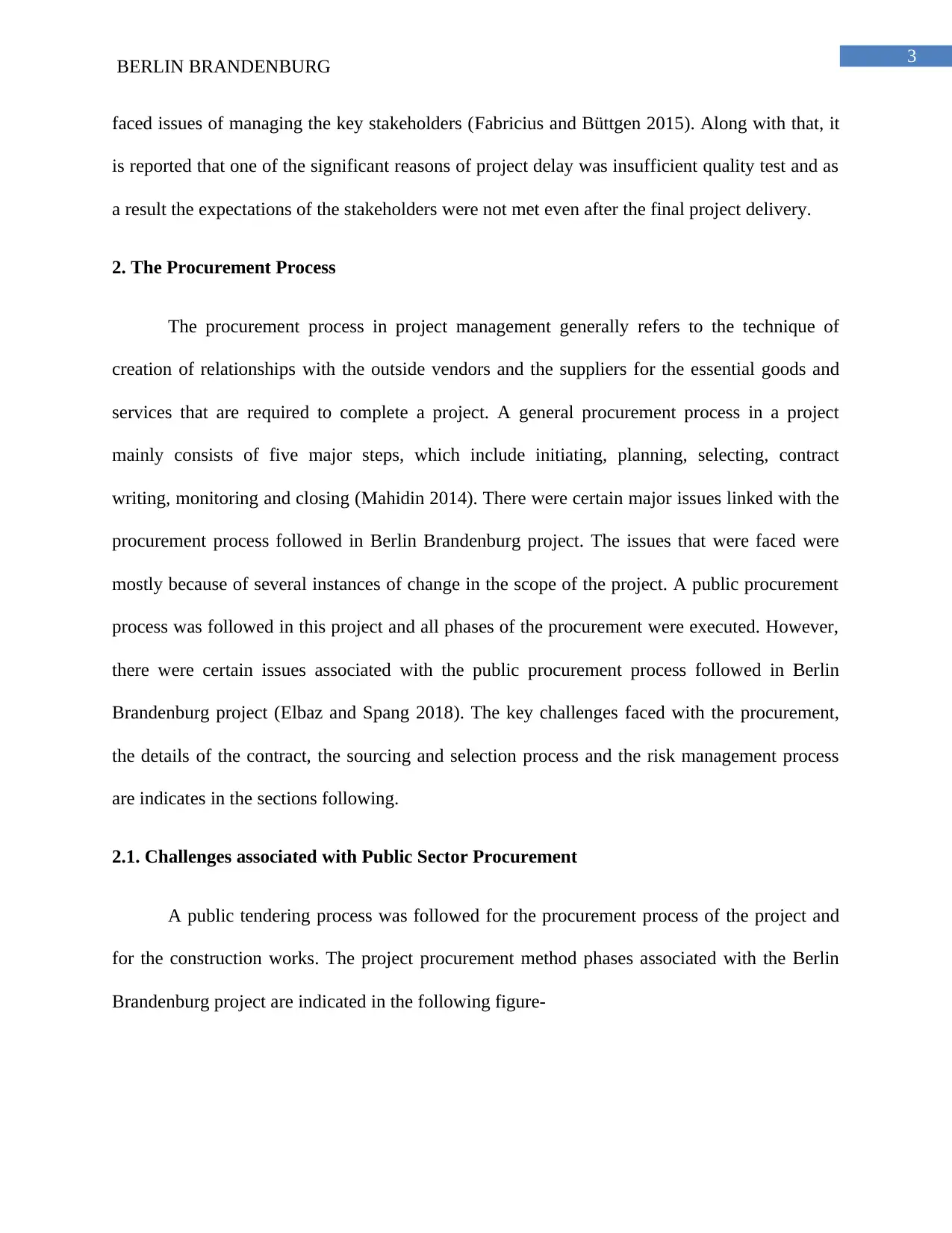
3
BERLIN BRANDENBURG
faced issues of managing the key stakeholders (Fabricius and Büttgen 2015). Along with that, it
is reported that one of the significant reasons of project delay was insufficient quality test and as
a result the expectations of the stakeholders were not met even after the final project delivery.
2. The Procurement Process
The procurement process in project management generally refers to the technique of
creation of relationships with the outside vendors and the suppliers for the essential goods and
services that are required to complete a project. A general procurement process in a project
mainly consists of five major steps, which include initiating, planning, selecting, contract
writing, monitoring and closing (Mahidin 2014). There were certain major issues linked with the
procurement process followed in Berlin Brandenburg project. The issues that were faced were
mostly because of several instances of change in the scope of the project. A public procurement
process was followed in this project and all phases of the procurement were executed. However,
there were certain issues associated with the public procurement process followed in Berlin
Brandenburg project (Elbaz and Spang 2018). The key challenges faced with the procurement,
the details of the contract, the sourcing and selection process and the risk management process
are indicates in the sections following.
2.1. Challenges associated with Public Sector Procurement
A public tendering process was followed for the procurement process of the project and
for the construction works. The project procurement method phases associated with the Berlin
Brandenburg project are indicated in the following figure-
BERLIN BRANDENBURG
faced issues of managing the key stakeholders (Fabricius and Büttgen 2015). Along with that, it
is reported that one of the significant reasons of project delay was insufficient quality test and as
a result the expectations of the stakeholders were not met even after the final project delivery.
2. The Procurement Process
The procurement process in project management generally refers to the technique of
creation of relationships with the outside vendors and the suppliers for the essential goods and
services that are required to complete a project. A general procurement process in a project
mainly consists of five major steps, which include initiating, planning, selecting, contract
writing, monitoring and closing (Mahidin 2014). There were certain major issues linked with the
procurement process followed in Berlin Brandenburg project. The issues that were faced were
mostly because of several instances of change in the scope of the project. A public procurement
process was followed in this project and all phases of the procurement were executed. However,
there were certain issues associated with the public procurement process followed in Berlin
Brandenburg project (Elbaz and Spang 2018). The key challenges faced with the procurement,
the details of the contract, the sourcing and selection process and the risk management process
are indicates in the sections following.
2.1. Challenges associated with Public Sector Procurement
A public tendering process was followed for the procurement process of the project and
for the construction works. The project procurement method phases associated with the Berlin
Brandenburg project are indicated in the following figure-
Paraphrase This Document
Need a fresh take? Get an instant paraphrase of this document with our AI Paraphraser
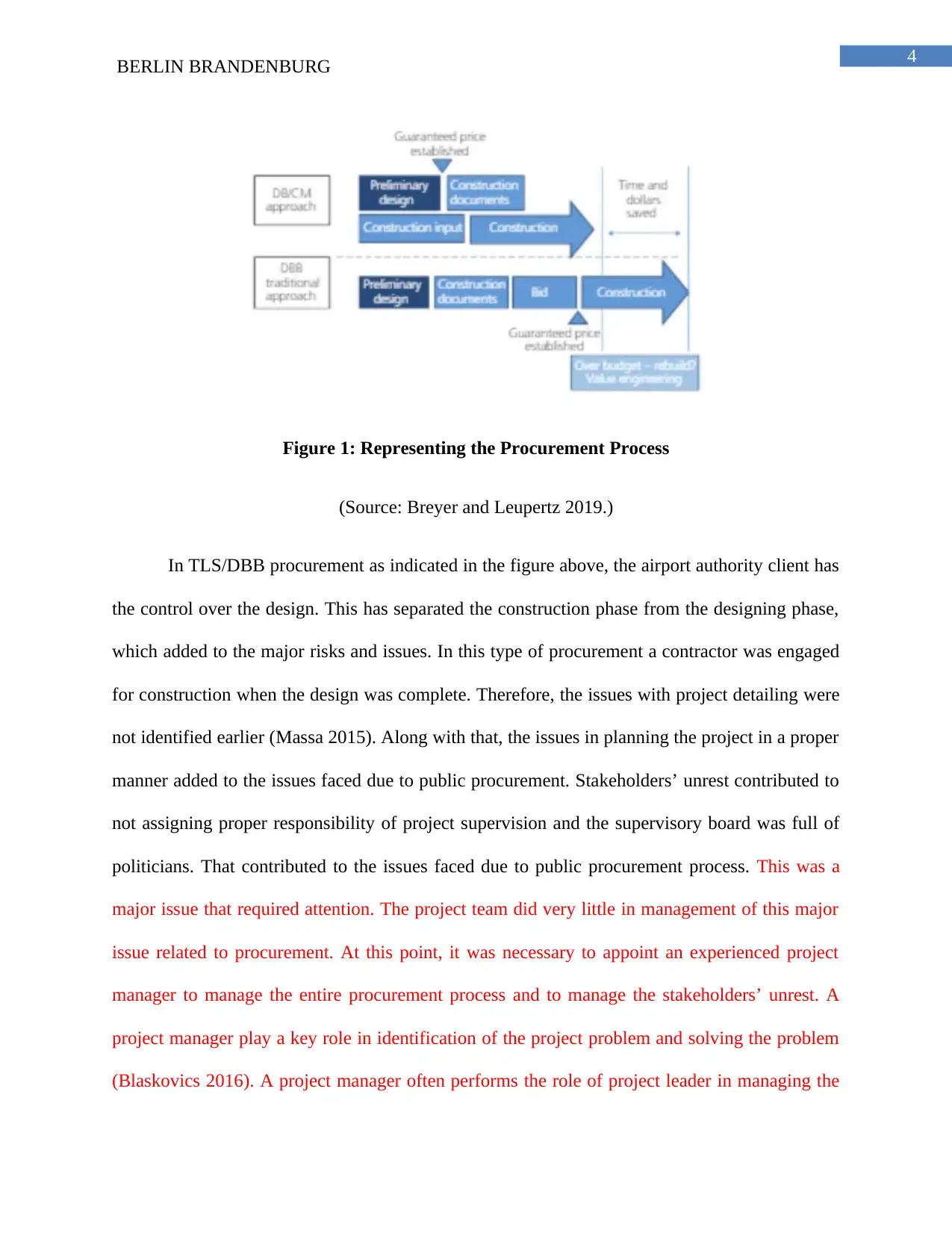
4
BERLIN BRANDENBURG
Figure 1: Representing the Procurement Process
(Source: Breyer and Leupertz 2019.)
In TLS/DBB procurement as indicated in the figure above, the airport authority client has
the control over the design. This has separated the construction phase from the designing phase,
which added to the major risks and issues. In this type of procurement a contractor was engaged
for construction when the design was complete. Therefore, the issues with project detailing were
not identified earlier (Massa 2015). Along with that, the issues in planning the project in a proper
manner added to the issues faced due to public procurement. Stakeholders’ unrest contributed to
not assigning proper responsibility of project supervision and the supervisory board was full of
politicians. That contributed to the issues faced due to public procurement process. This was a
major issue that required attention. The project team did very little in management of this major
issue related to procurement. At this point, it was necessary to appoint an experienced project
manager to manage the entire procurement process and to manage the stakeholders’ unrest. A
project manager play a key role in identification of the project problem and solving the problem
(Blaskovics 2016). A project manager often performs the role of project leader in managing the
BERLIN BRANDENBURG
Figure 1: Representing the Procurement Process
(Source: Breyer and Leupertz 2019.)
In TLS/DBB procurement as indicated in the figure above, the airport authority client has
the control over the design. This has separated the construction phase from the designing phase,
which added to the major risks and issues. In this type of procurement a contractor was engaged
for construction when the design was complete. Therefore, the issues with project detailing were
not identified earlier (Massa 2015). Along with that, the issues in planning the project in a proper
manner added to the issues faced due to public procurement. Stakeholders’ unrest contributed to
not assigning proper responsibility of project supervision and the supervisory board was full of
politicians. That contributed to the issues faced due to public procurement process. This was a
major issue that required attention. The project team did very little in management of this major
issue related to procurement. At this point, it was necessary to appoint an experienced project
manager to manage the entire procurement process and to manage the stakeholders’ unrest. A
project manager play a key role in identification of the project problem and solving the problem
(Blaskovics 2016). A project manager often performs the role of project leader in managing the
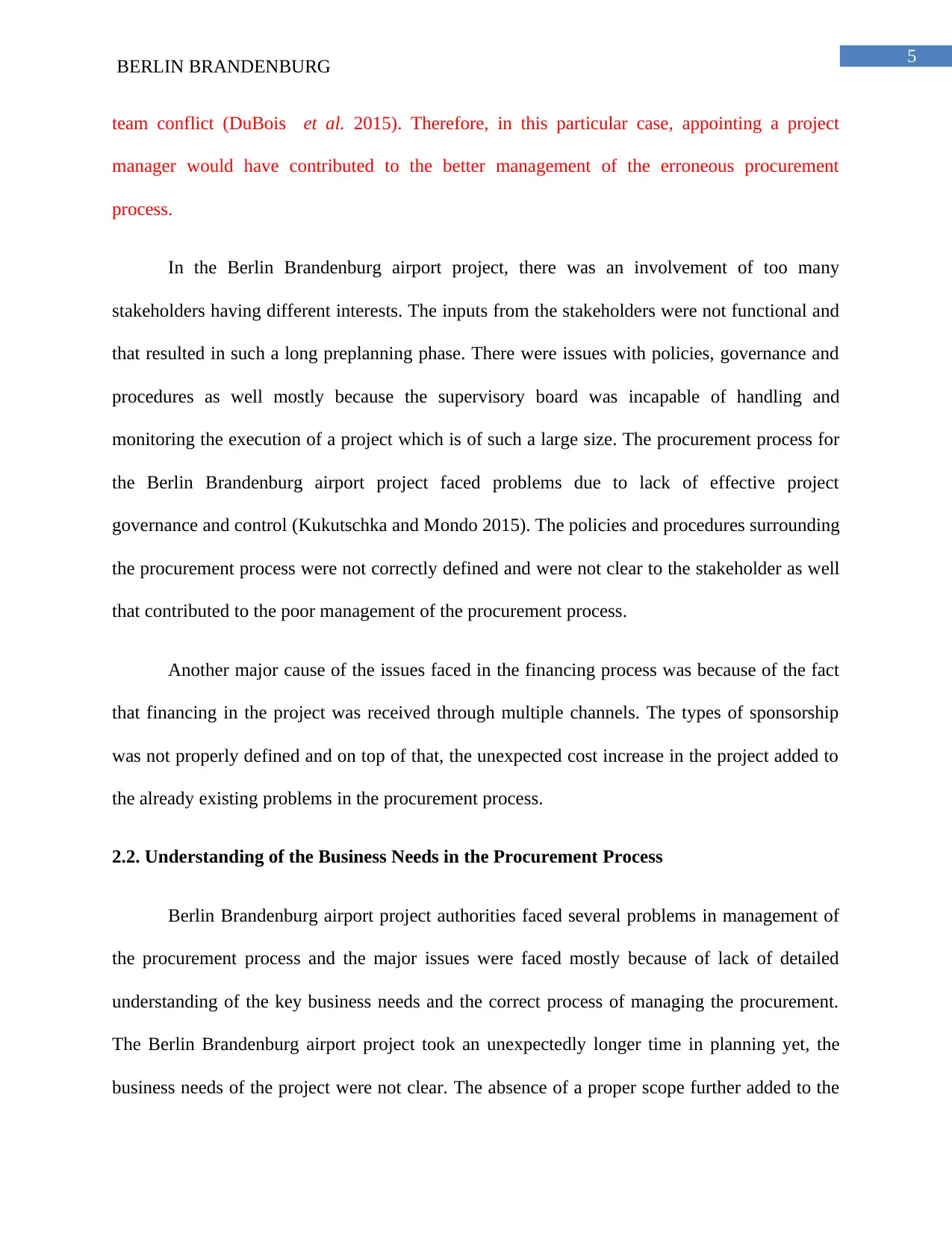
5
BERLIN BRANDENBURG
team conflict (DuBois et al. 2015). Therefore, in this particular case, appointing a project
manager would have contributed to the better management of the erroneous procurement
process.
In the Berlin Brandenburg airport project, there was an involvement of too many
stakeholders having different interests. The inputs from the stakeholders were not functional and
that resulted in such a long preplanning phase. There were issues with policies, governance and
procedures as well mostly because the supervisory board was incapable of handling and
monitoring the execution of a project which is of such a large size. The procurement process for
the Berlin Brandenburg airport project faced problems due to lack of effective project
governance and control (Kukutschka and Mondo 2015). The policies and procedures surrounding
the procurement process were not correctly defined and were not clear to the stakeholder as well
that contributed to the poor management of the procurement process.
Another major cause of the issues faced in the financing process was because of the fact
that financing in the project was received through multiple channels. The types of sponsorship
was not properly defined and on top of that, the unexpected cost increase in the project added to
the already existing problems in the procurement process.
2.2. Understanding of the Business Needs in the Procurement Process
Berlin Brandenburg airport project authorities faced several problems in management of
the procurement process and the major issues were faced mostly because of lack of detailed
understanding of the key business needs and the correct process of managing the procurement.
The Berlin Brandenburg airport project took an unexpectedly longer time in planning yet, the
business needs of the project were not clear. The absence of a proper scope further added to the
BERLIN BRANDENBURG
team conflict (DuBois et al. 2015). Therefore, in this particular case, appointing a project
manager would have contributed to the better management of the erroneous procurement
process.
In the Berlin Brandenburg airport project, there was an involvement of too many
stakeholders having different interests. The inputs from the stakeholders were not functional and
that resulted in such a long preplanning phase. There were issues with policies, governance and
procedures as well mostly because the supervisory board was incapable of handling and
monitoring the execution of a project which is of such a large size. The procurement process for
the Berlin Brandenburg airport project faced problems due to lack of effective project
governance and control (Kukutschka and Mondo 2015). The policies and procedures surrounding
the procurement process were not correctly defined and were not clear to the stakeholder as well
that contributed to the poor management of the procurement process.
Another major cause of the issues faced in the financing process was because of the fact
that financing in the project was received through multiple channels. The types of sponsorship
was not properly defined and on top of that, the unexpected cost increase in the project added to
the already existing problems in the procurement process.
2.2. Understanding of the Business Needs in the Procurement Process
Berlin Brandenburg airport project authorities faced several problems in management of
the procurement process and the major issues were faced mostly because of lack of detailed
understanding of the key business needs and the correct process of managing the procurement.
The Berlin Brandenburg airport project took an unexpectedly longer time in planning yet, the
business needs of the project were not clear. The absence of a proper scope further added to the
⊘ This is a preview!⊘
Do you want full access?
Subscribe today to unlock all pages.

Trusted by 1+ million students worldwide
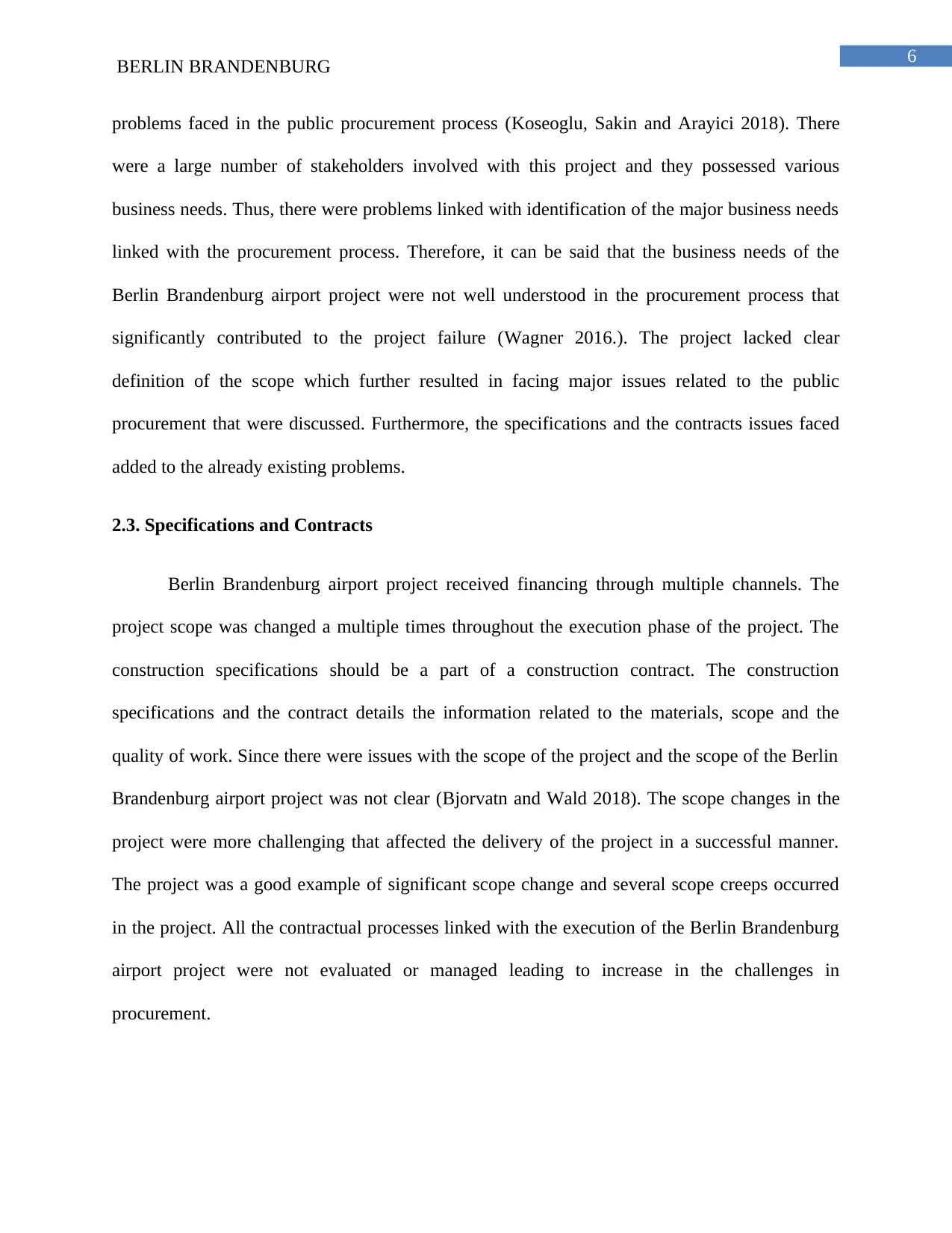
6
BERLIN BRANDENBURG
problems faced in the public procurement process (Koseoglu, Sakin and Arayici 2018). There
were a large number of stakeholders involved with this project and they possessed various
business needs. Thus, there were problems linked with identification of the major business needs
linked with the procurement process. Therefore, it can be said that the business needs of the
Berlin Brandenburg airport project were not well understood in the procurement process that
significantly contributed to the project failure (Wagner 2016.). The project lacked clear
definition of the scope which further resulted in facing major issues related to the public
procurement that were discussed. Furthermore, the specifications and the contracts issues faced
added to the already existing problems.
2.3. Specifications and Contracts
Berlin Brandenburg airport project received financing through multiple channels. The
project scope was changed a multiple times throughout the execution phase of the project. The
construction specifications should be a part of a construction contract. The construction
specifications and the contract details the information related to the materials, scope and the
quality of work. Since there were issues with the scope of the project and the scope of the Berlin
Brandenburg airport project was not clear (Bjorvatn and Wald 2018). The scope changes in the
project were more challenging that affected the delivery of the project in a successful manner.
The project was a good example of significant scope change and several scope creeps occurred
in the project. All the contractual processes linked with the execution of the Berlin Brandenburg
airport project were not evaluated or managed leading to increase in the challenges in
procurement.
BERLIN BRANDENBURG
problems faced in the public procurement process (Koseoglu, Sakin and Arayici 2018). There
were a large number of stakeholders involved with this project and they possessed various
business needs. Thus, there were problems linked with identification of the major business needs
linked with the procurement process. Therefore, it can be said that the business needs of the
Berlin Brandenburg airport project were not well understood in the procurement process that
significantly contributed to the project failure (Wagner 2016.). The project lacked clear
definition of the scope which further resulted in facing major issues related to the public
procurement that were discussed. Furthermore, the specifications and the contracts issues faced
added to the already existing problems.
2.3. Specifications and Contracts
Berlin Brandenburg airport project received financing through multiple channels. The
project scope was changed a multiple times throughout the execution phase of the project. The
construction specifications should be a part of a construction contract. The construction
specifications and the contract details the information related to the materials, scope and the
quality of work. Since there were issues with the scope of the project and the scope of the Berlin
Brandenburg airport project was not clear (Bjorvatn and Wald 2018). The scope changes in the
project were more challenging that affected the delivery of the project in a successful manner.
The project was a good example of significant scope change and several scope creeps occurred
in the project. All the contractual processes linked with the execution of the Berlin Brandenburg
airport project were not evaluated or managed leading to increase in the challenges in
procurement.
Paraphrase This Document
Need a fresh take? Get an instant paraphrase of this document with our AI Paraphraser
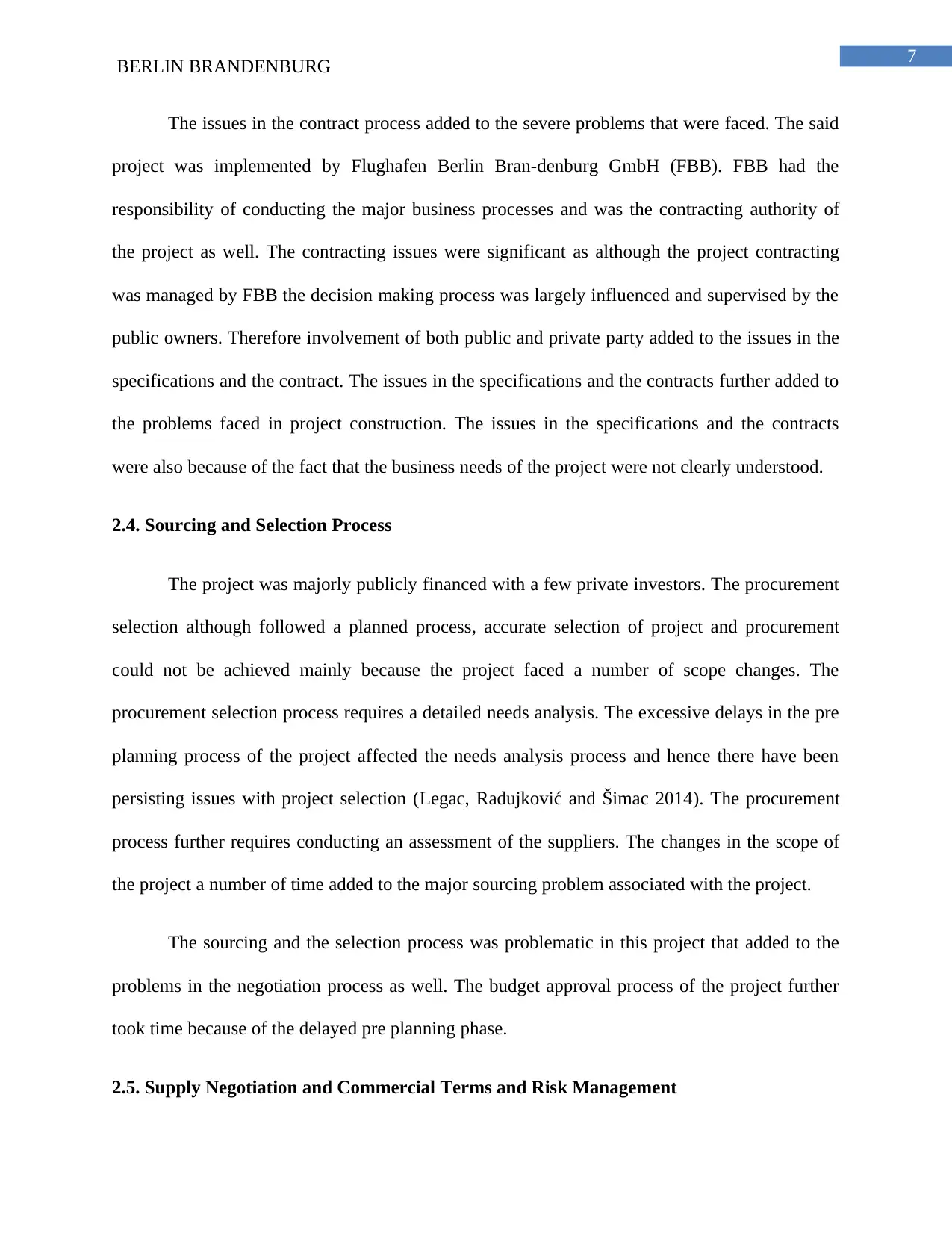
7
BERLIN BRANDENBURG
The issues in the contract process added to the severe problems that were faced. The said
project was implemented by Flughafen Berlin Bran-denburg GmbH (FBB). FBB had the
responsibility of conducting the major business processes and was the contracting authority of
the project as well. The contracting issues were significant as although the project contracting
was managed by FBB the decision making process was largely influenced and supervised by the
public owners. Therefore involvement of both public and private party added to the issues in the
specifications and the contract. The issues in the specifications and the contracts further added to
the problems faced in project construction. The issues in the specifications and the contracts
were also because of the fact that the business needs of the project were not clearly understood.
2.4. Sourcing and Selection Process
The project was majorly publicly financed with a few private investors. The procurement
selection although followed a planned process, accurate selection of project and procurement
could not be achieved mainly because the project faced a number of scope changes. The
procurement selection process requires a detailed needs analysis. The excessive delays in the pre
planning process of the project affected the needs analysis process and hence there have been
persisting issues with project selection (Legac, Radujković and Šimac 2014). The procurement
process further requires conducting an assessment of the suppliers. The changes in the scope of
the project a number of time added to the major sourcing problem associated with the project.
The sourcing and the selection process was problematic in this project that added to the
problems in the negotiation process as well. The budget approval process of the project further
took time because of the delayed pre planning phase.
2.5. Supply Negotiation and Commercial Terms and Risk Management
BERLIN BRANDENBURG
The issues in the contract process added to the severe problems that were faced. The said
project was implemented by Flughafen Berlin Bran-denburg GmbH (FBB). FBB had the
responsibility of conducting the major business processes and was the contracting authority of
the project as well. The contracting issues were significant as although the project contracting
was managed by FBB the decision making process was largely influenced and supervised by the
public owners. Therefore involvement of both public and private party added to the issues in the
specifications and the contract. The issues in the specifications and the contracts further added to
the problems faced in project construction. The issues in the specifications and the contracts
were also because of the fact that the business needs of the project were not clearly understood.
2.4. Sourcing and Selection Process
The project was majorly publicly financed with a few private investors. The procurement
selection although followed a planned process, accurate selection of project and procurement
could not be achieved mainly because the project faced a number of scope changes. The
procurement selection process requires a detailed needs analysis. The excessive delays in the pre
planning process of the project affected the needs analysis process and hence there have been
persisting issues with project selection (Legac, Radujković and Šimac 2014). The procurement
process further requires conducting an assessment of the suppliers. The changes in the scope of
the project a number of time added to the major sourcing problem associated with the project.
The sourcing and the selection process was problematic in this project that added to the
problems in the negotiation process as well. The budget approval process of the project further
took time because of the delayed pre planning phase.
2.5. Supply Negotiation and Commercial Terms and Risk Management
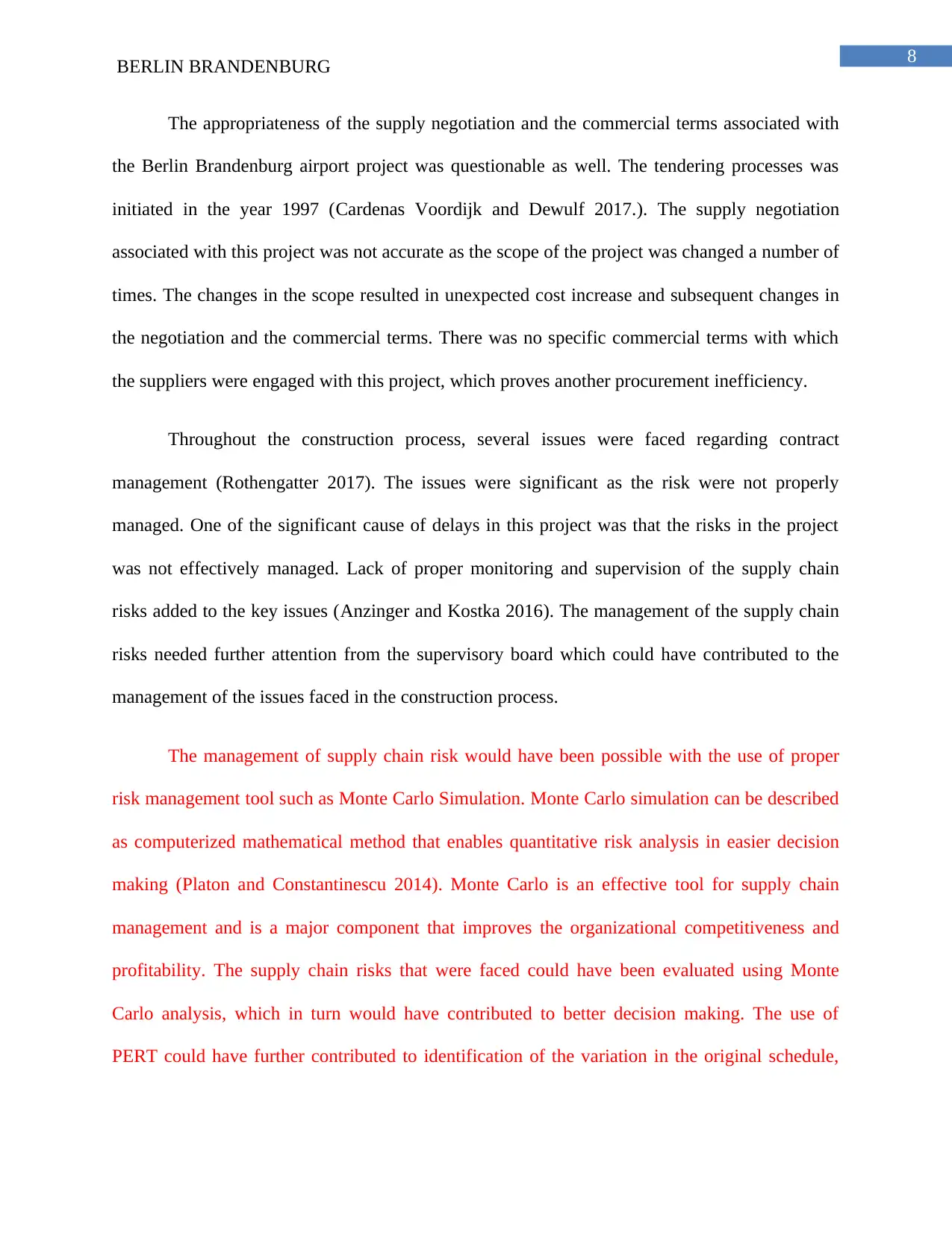
8
BERLIN BRANDENBURG
The appropriateness of the supply negotiation and the commercial terms associated with
the Berlin Brandenburg airport project was questionable as well. The tendering processes was
initiated in the year 1997 (Cardenas Voordijk and Dewulf 2017.). The supply negotiation
associated with this project was not accurate as the scope of the project was changed a number of
times. The changes in the scope resulted in unexpected cost increase and subsequent changes in
the negotiation and the commercial terms. There was no specific commercial terms with which
the suppliers were engaged with this project, which proves another procurement inefficiency.
Throughout the construction process, several issues were faced regarding contract
management (Rothengatter 2017). The issues were significant as the risk were not properly
managed. One of the significant cause of delays in this project was that the risks in the project
was not effectively managed. Lack of proper monitoring and supervision of the supply chain
risks added to the key issues (Anzinger and Kostka 2016). The management of the supply chain
risks needed further attention from the supervisory board which could have contributed to the
management of the issues faced in the construction process.
The management of supply chain risk would have been possible with the use of proper
risk management tool such as Monte Carlo Simulation. Monte Carlo simulation can be described
as computerized mathematical method that enables quantitative risk analysis in easier decision
making (Platon and Constantinescu 2014). Monte Carlo is an effective tool for supply chain
management and is a major component that improves the organizational competitiveness and
profitability. The supply chain risks that were faced could have been evaluated using Monte
Carlo analysis, which in turn would have contributed to better decision making. The use of
PERT could have further contributed to identification of the variation in the original schedule,
BERLIN BRANDENBURG
The appropriateness of the supply negotiation and the commercial terms associated with
the Berlin Brandenburg airport project was questionable as well. The tendering processes was
initiated in the year 1997 (Cardenas Voordijk and Dewulf 2017.). The supply negotiation
associated with this project was not accurate as the scope of the project was changed a number of
times. The changes in the scope resulted in unexpected cost increase and subsequent changes in
the negotiation and the commercial terms. There was no specific commercial terms with which
the suppliers were engaged with this project, which proves another procurement inefficiency.
Throughout the construction process, several issues were faced regarding contract
management (Rothengatter 2017). The issues were significant as the risk were not properly
managed. One of the significant cause of delays in this project was that the risks in the project
was not effectively managed. Lack of proper monitoring and supervision of the supply chain
risks added to the key issues (Anzinger and Kostka 2016). The management of the supply chain
risks needed further attention from the supervisory board which could have contributed to the
management of the issues faced in the construction process.
The management of supply chain risk would have been possible with the use of proper
risk management tool such as Monte Carlo Simulation. Monte Carlo simulation can be described
as computerized mathematical method that enables quantitative risk analysis in easier decision
making (Platon and Constantinescu 2014). Monte Carlo is an effective tool for supply chain
management and is a major component that improves the organizational competitiveness and
profitability. The supply chain risks that were faced could have been evaluated using Monte
Carlo analysis, which in turn would have contributed to better decision making. The use of
PERT could have further contributed to identification of the variation in the original schedule,
⊘ This is a preview!⊘
Do you want full access?
Subscribe today to unlock all pages.

Trusted by 1+ million students worldwide
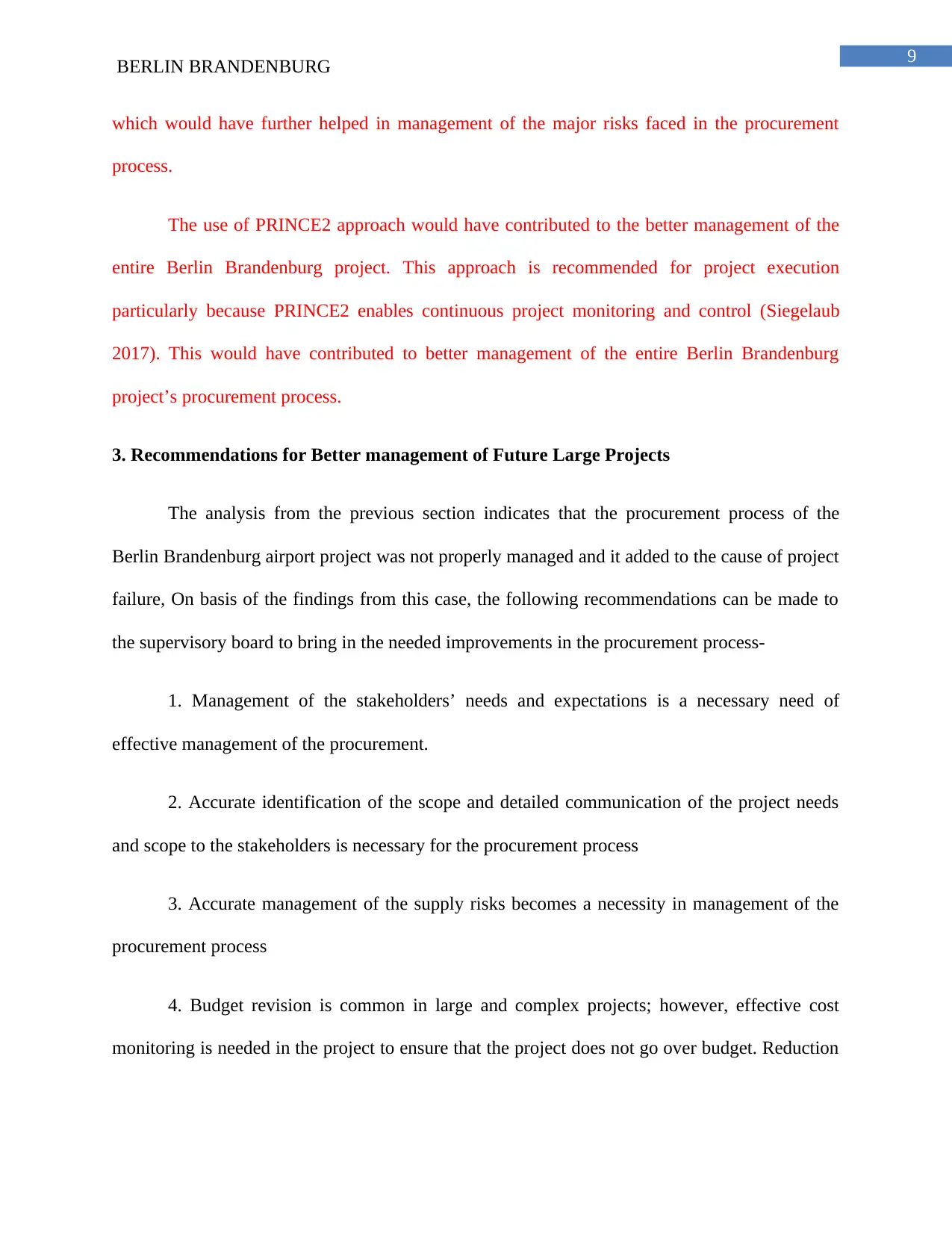
9
BERLIN BRANDENBURG
which would have further helped in management of the major risks faced in the procurement
process.
The use of PRINCE2 approach would have contributed to the better management of the
entire Berlin Brandenburg project. This approach is recommended for project execution
particularly because PRINCE2 enables continuous project monitoring and control (Siegelaub
2017). This would have contributed to better management of the entire Berlin Brandenburg
project’s procurement process.
3. Recommendations for Better management of Future Large Projects
The analysis from the previous section indicates that the procurement process of the
Berlin Brandenburg airport project was not properly managed and it added to the cause of project
failure, On basis of the findings from this case, the following recommendations can be made to
the supervisory board to bring in the needed improvements in the procurement process-
1. Management of the stakeholders’ needs and expectations is a necessary need of
effective management of the procurement.
2. Accurate identification of the scope and detailed communication of the project needs
and scope to the stakeholders is necessary for the procurement process
3. Accurate management of the supply risks becomes a necessity in management of the
procurement process
4. Budget revision is common in large and complex projects; however, effective cost
monitoring is needed in the project to ensure that the project does not go over budget. Reduction
BERLIN BRANDENBURG
which would have further helped in management of the major risks faced in the procurement
process.
The use of PRINCE2 approach would have contributed to the better management of the
entire Berlin Brandenburg project. This approach is recommended for project execution
particularly because PRINCE2 enables continuous project monitoring and control (Siegelaub
2017). This would have contributed to better management of the entire Berlin Brandenburg
project’s procurement process.
3. Recommendations for Better management of Future Large Projects
The analysis from the previous section indicates that the procurement process of the
Berlin Brandenburg airport project was not properly managed and it added to the cause of project
failure, On basis of the findings from this case, the following recommendations can be made to
the supervisory board to bring in the needed improvements in the procurement process-
1. Management of the stakeholders’ needs and expectations is a necessary need of
effective management of the procurement.
2. Accurate identification of the scope and detailed communication of the project needs
and scope to the stakeholders is necessary for the procurement process
3. Accurate management of the supply risks becomes a necessity in management of the
procurement process
4. Budget revision is common in large and complex projects; however, effective cost
monitoring is needed in the project to ensure that the project does not go over budget. Reduction
Paraphrase This Document
Need a fresh take? Get an instant paraphrase of this document with our AI Paraphraser
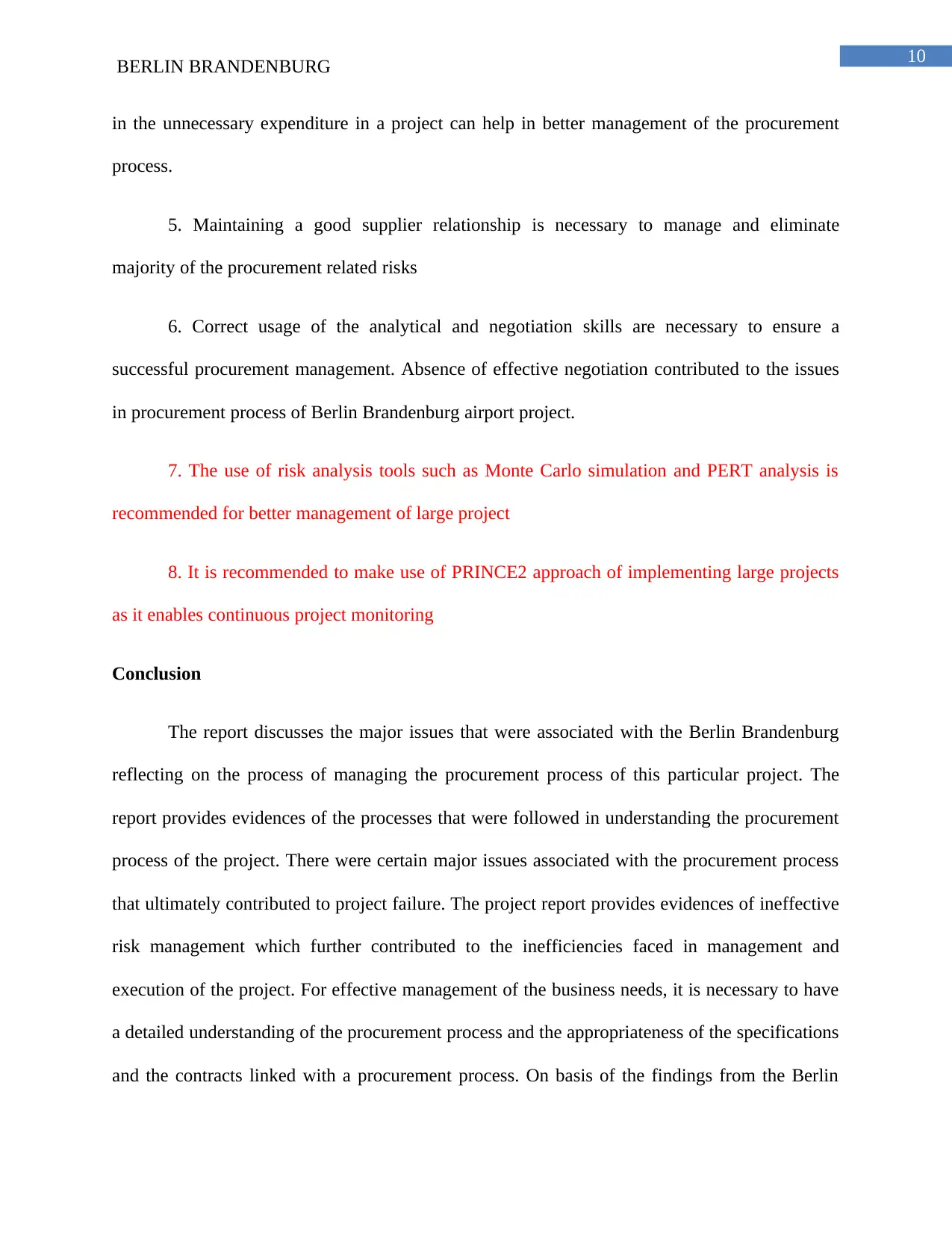
10
BERLIN BRANDENBURG
in the unnecessary expenditure in a project can help in better management of the procurement
process.
5. Maintaining a good supplier relationship is necessary to manage and eliminate
majority of the procurement related risks
6. Correct usage of the analytical and negotiation skills are necessary to ensure a
successful procurement management. Absence of effective negotiation contributed to the issues
in procurement process of Berlin Brandenburg airport project.
7. The use of risk analysis tools such as Monte Carlo simulation and PERT analysis is
recommended for better management of large project
8. It is recommended to make use of PRINCE2 approach of implementing large projects
as it enables continuous project monitoring
Conclusion
The report discusses the major issues that were associated with the Berlin Brandenburg
reflecting on the process of managing the procurement process of this particular project. The
report provides evidences of the processes that were followed in understanding the procurement
process of the project. There were certain major issues associated with the procurement process
that ultimately contributed to project failure. The project report provides evidences of ineffective
risk management which further contributed to the inefficiencies faced in management and
execution of the project. For effective management of the business needs, it is necessary to have
a detailed understanding of the procurement process and the appropriateness of the specifications
and the contracts linked with a procurement process. On basis of the findings from the Berlin
BERLIN BRANDENBURG
in the unnecessary expenditure in a project can help in better management of the procurement
process.
5. Maintaining a good supplier relationship is necessary to manage and eliminate
majority of the procurement related risks
6. Correct usage of the analytical and negotiation skills are necessary to ensure a
successful procurement management. Absence of effective negotiation contributed to the issues
in procurement process of Berlin Brandenburg airport project.
7. The use of risk analysis tools such as Monte Carlo simulation and PERT analysis is
recommended for better management of large project
8. It is recommended to make use of PRINCE2 approach of implementing large projects
as it enables continuous project monitoring
Conclusion
The report discusses the major issues that were associated with the Berlin Brandenburg
reflecting on the process of managing the procurement process of this particular project. The
report provides evidences of the processes that were followed in understanding the procurement
process of the project. There were certain major issues associated with the procurement process
that ultimately contributed to project failure. The project report provides evidences of ineffective
risk management which further contributed to the inefficiencies faced in management and
execution of the project. For effective management of the business needs, it is necessary to have
a detailed understanding of the procurement process and the appropriateness of the specifications
and the contracts linked with a procurement process. On basis of the findings from the Berlin
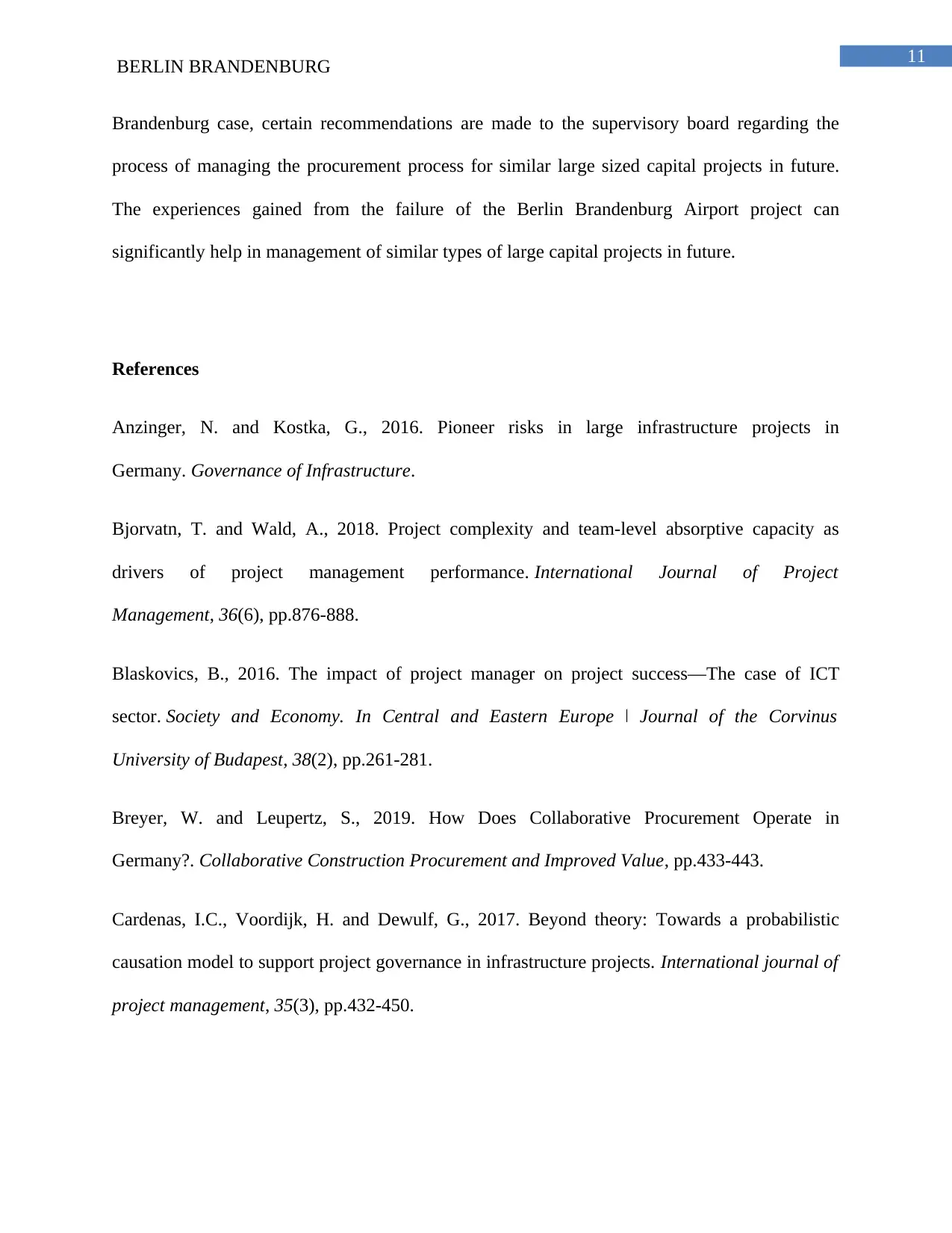
11
BERLIN BRANDENBURG
Brandenburg case, certain recommendations are made to the supervisory board regarding the
process of managing the procurement process for similar large sized capital projects in future.
The experiences gained from the failure of the Berlin Brandenburg Airport project can
significantly help in management of similar types of large capital projects in future.
References
Anzinger, N. and Kostka, G., 2016. Pioneer risks in large infrastructure projects in
Germany. Governance of Infrastructure.
Bjorvatn, T. and Wald, A., 2018. Project complexity and team-level absorptive capacity as
drivers of project management performance. International Journal of Project
Management, 36(6), pp.876-888.
Blaskovics, B., 2016. The impact of project manager on project success—The case of ICT
sector. Society and Economy. In Central and Eastern Europe ǀ Journal of the Corvinus
University of Budapest, 38(2), pp.261-281.
Breyer, W. and Leupertz, S., 2019. How Does Collaborative Procurement Operate in
Germany?. Collaborative Construction Procurement and Improved Value, pp.433-443.
Cardenas, I.C., Voordijk, H. and Dewulf, G., 2017. Beyond theory: Towards a probabilistic
causation model to support project governance in infrastructure projects. International journal of
project management, 35(3), pp.432-450.
BERLIN BRANDENBURG
Brandenburg case, certain recommendations are made to the supervisory board regarding the
process of managing the procurement process for similar large sized capital projects in future.
The experiences gained from the failure of the Berlin Brandenburg Airport project can
significantly help in management of similar types of large capital projects in future.
References
Anzinger, N. and Kostka, G., 2016. Pioneer risks in large infrastructure projects in
Germany. Governance of Infrastructure.
Bjorvatn, T. and Wald, A., 2018. Project complexity and team-level absorptive capacity as
drivers of project management performance. International Journal of Project
Management, 36(6), pp.876-888.
Blaskovics, B., 2016. The impact of project manager on project success—The case of ICT
sector. Society and Economy. In Central and Eastern Europe ǀ Journal of the Corvinus
University of Budapest, 38(2), pp.261-281.
Breyer, W. and Leupertz, S., 2019. How Does Collaborative Procurement Operate in
Germany?. Collaborative Construction Procurement and Improved Value, pp.433-443.
Cardenas, I.C., Voordijk, H. and Dewulf, G., 2017. Beyond theory: Towards a probabilistic
causation model to support project governance in infrastructure projects. International journal of
project management, 35(3), pp.432-450.
⊘ This is a preview!⊘
Do you want full access?
Subscribe today to unlock all pages.

Trusted by 1+ million students worldwide
1 out of 14
Related Documents
Your All-in-One AI-Powered Toolkit for Academic Success.
+13062052269
info@desklib.com
Available 24*7 on WhatsApp / Email
![[object Object]](/_next/static/media/star-bottom.7253800d.svg)
Unlock your academic potential
Copyright © 2020–2025 A2Z Services. All Rights Reserved. Developed and managed by ZUCOL.





